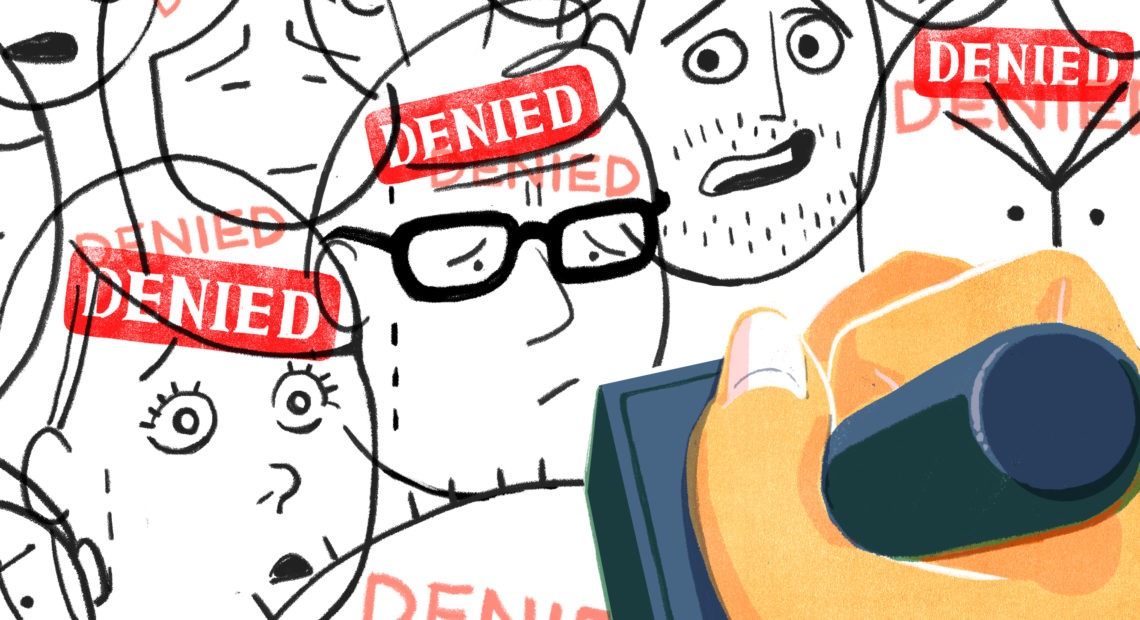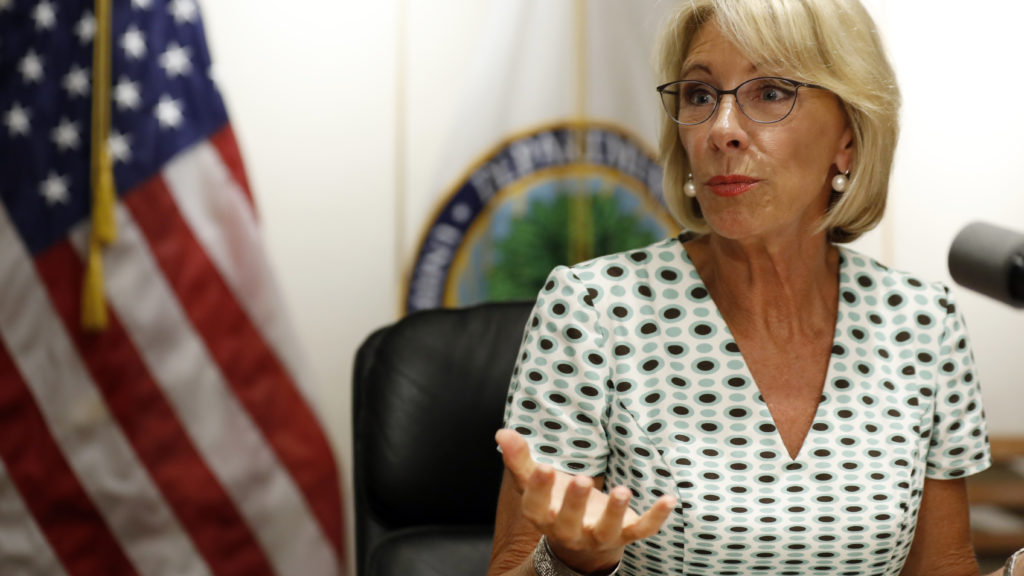
Congress Promised Student Borrowers A Break. Education Department Rejected 99% Of Them
IMAGE CREDIT: Delphine Lee/NPR
LISTEN
BY CORY TURNER
A new report from a government watchdog, first obtained obtained by NPR, says an expanded effort by Congress to forgive the student loans of public servants is remarkably unforgiving.
Congress created the expansion program last year in response to a growing outcry. Thousands of borrowers — nurses, teachers and other public servants — complained that the requirements for the original program were so rigid and poorly communicated that lawmakers needed to step in. But, documents show, even this expansion of the Public Service Loan Forgiveness (PSLF) program isn’t working.
Ninety-nine percent of loan-forgiveness requests under that new Temporary Expanded Public Service Loan Forgiveness (TEPSLF) were rejected during the program’s first year, from May 2018 to May 2019. According to the review out Thursday, conducted by the Government Accountability Office, the U.S. Department of Education processed roughly 54,000 requests and approved just 661. It spent only $27 million of the $700 million Congress set aside for the expansion.
“We were disheartened,” says Melissa Emrey-Arras, who led the GAO’s review. “I think we were discouraged. I mean, the hope is that you have this temporary expanded process, and you want it to help a lot of people. And you don’t want borrowers to be confused about the eligibility criteria and to face a high denial rate. And yet, that’s what we found.”
In a statement to NPR, Education Department press secretary Angela Morabito says, “The Department has taken steps to help borrowers better understand the complex eligibility requirements, application process, benefits, and other information related to the PSLF and TEPSLF programs. The Department agrees with the GAO’s recommendations about how to improve the programs; a number of our efforts are already underway.”
“Stumbling in the darkness”
“What sort of Kafkaesque thing are we in here?” asks Matthew Austin, exasperated by his recent experience with the PSLF expansion. “It’s like we’re just stumbling in the darkness.”
Every Monday night, Matthew sits down at his desk in the Connecticut home he shares with his wife, Heather, to pay the family’s bills. He clearly remembers opening a letter in the summer of 2018 from the company that manages Heather’s federal student loans.
She had spent more than a decade in public service as a teacher. The couple was looking forward to the day when, under the original PSLF program, the Education Department would forgive her student loans. But the letter did not say “congratulations.”

Education Secretary Betsy DeVos speaks with the media after a series of listening sessions about campus sexual violence in July 2017. CREDIT: Alex Brandon/AP
“My jaw just kind of dropped,” Matthew says. (Heather did not want to talk about what has been a long, painful odyssey for them both.) The letter instead informed the Austins that, much to their surprise, none of the loan payments they had made over the previous decade had counted toward the 120 monthly payments required to receive loan forgiveness. Not one.
“I saw zero,” Matthew says. “And I started seeing red.”
Many borrowers have had similar experiences with PSLF, believing for years that they were working toward loan forgiveness only to realize later that they had been in the wrong repayment plan or held the wrong type of loan. The Austins have spent more than a decade planning for the day when Heather would be free from those loans. The promise of PSLF has been in their family longer than their three children.
“It just infuriates me,” Matthew says. “I remember sitting there when we found out that Heather was pregnant with our first child. And looking at the spreadsheet that we had made up for our long-term plan of the budget. And saying, ‘OK, well, when he’s 10, we can take a vacation.”
Then came good news: A few months before Matthew Austin opened that letter, Congress created the emergency expansion of the PSLF program in response to an outcry from borrowers like the Austins. Lawmakers set aside $700 million to help people who, like Heather, had fulfilled their public service but were, unbeknownst to them, in the wrong repayment plan. Naturally, the Austins applied. But the nightmare continued.
Matthew says their request for TEPSLF was denied, this time on a technicality — “because we had not been denied for PSLF.” According to the GAO report, this is a common complaint. In its rush to implement this expansion of Public Service Loan Forgiveness, the Education Department decided to require borrowers who believe they qualify for TEPSLF to first apply for, and be denied, PSLF.
It’s a hurdle Congress did not ask for. In fact, knowing that borrowers were already feeling frustrated and disillusioned with PSLF, lawmakers directed the Department of Education to do the opposite, to make this expansion easy to access: “The Secretary shall develop and make available a simple method for borrowers to apply for loan cancellation.”
According to the GAO’s yearlong review of the program, 71% of all TEPSLF denials were rejected because of this one hurdle — asking borrowers to first apply for a program they know they do not qualify for. That’s 38,068 requests denied. It is unclear how many of those borrowers, once they are denied PSLF, would technically qualify for TEPSLF.
“This can be confusing to borrowers,” the GAO’s Emrey-Arras tells NPR. “It doesn’t make a lot of sense, from a borrower perspective, as to why you would need to apply for a program that you know you’re ineligible for. Yet that’s the way the process works.”
The Education Department “has not created a borrower-friendly TEPSLF process,” the GAO says. “This does not align with Education’s strategic plan objective to improve the quality of service to customers across the student aid life cycle.”
The Austins found the process so confusing that after being rejected for TEPSLF, instead of further pleading their case with their loan servicer or the Education Department, they contacted one of their U.S. senators. And members of Congress are listening.
“[The Education Department has] not competently administered this program,” says U.S. Rep. Bobby Scott, a Virginia Democrat and chairman of the House education committee. He vows to hold public hearings about the department’s handling of PSLF and now TEPSLF.
“The students are entitled to it,” Scott adds. “They have fulfilled their responsibility over a decade of public service, and they’re entitled by law to have those loans discharged. … It is the constitutional responsibility of the executive branch to take care that the laws be faithfully executed, and we will focus public attention on the fact that they are not doing it.”
Congress created Public Service Loan Forgiveness in 2007, hoping to encourage promising college graduates into public service careers. In return for 10 years of government or not-for-profit work and 120 qualified student loan payments, borrowers were told the U.S. Department of Education would forgive whatever remained of their federal student loans. But the program’s requirements are so rigid, and were so poorly communicated in those early days, that the overwhelming majority of borrowers have, so far, been rejected.
The Austins, for example, appear to have run afoul of PSLF when their first son was born and Heather took a year off from work. They requested and received a one-year deferment. But when the couple resumed making payments, they did not realize — and they say they were never told — that their new repayment plan disqualified them from loan forgiveness.
As of March 2019, 99% of Public Service Loan Forgiveness requests have been rejected, and applicants remain deeply confused about the program’s rules.
“This wasn’t a puzzle or a lottery,” says Rep. Scott. “This is a program where, if you fulfill your responsibilities … then your student loan would be forgiven. It’s just incredible that we had to, last year, pass legislation … to create an emergency program.”
Now, Scott says, it is inexcusable that this emergency program is rejecting borrowers’ requests for loan forgiveness at the same rate — 99% — as the troubled program it was meant to alleviate.
In its new review, GAO investigators also criticize the Education Department for not clearly explaining to borrowers how the program works or how they can contest a denial.
For example, the GAO report says, when borrowers are rejected for TEPSLF, the letter they receive does not clearly explain the options for requesting a second review of their claim. Investigators also point out that, given the high potential for error by the company that manages TEPSLF, it “is especially important” that borrowers understand how to dispute an erroneous rejection.
While the vast majority of borrowers’ TEPSLF requests (71%) were denied because they had not yet applied for PSLF, 10% of requests were rejected because borrowers had not been repaying their loans for a full 10 years. Another 6% got hung up on a technicality created by Congress: When borrowers apply for help, their most recent payment, as well as the payment they made 12 months before applying, must be equal to or greater than what they would have paid on an income-driven repayment plan.
“That was ridiculous,” says Lana Scott, whose TEPSLF application was among the 6% that were rejected because her recent payments were not considered adequate. After being denied PSLF, Scott says she called her loan servicer and asked exactly what she would need to do to qualify for TEPSLF. “None of it was actually told to me over the phone.”
In this new review, GAO investigators push the Education Department to make it easier for borrowers to find information about the program’s strict requirements. For example, the department has an online help tool for people hoping to apply for Public Service Loan Forgiveness, but the tool provides no guidance for applying for TEPSLF.
The GAO also recommends that the Education Department streamline the TEPSLF application process and be much more transparent with borrowers about the program’s process and requirements.















